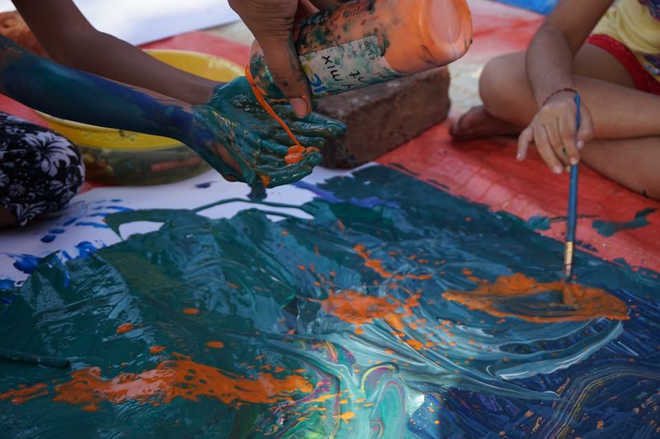
Saying it out: Non-verbal communication like drawing and painting are an easy tool to express fear
Surekha Kadapa-Bose
The working parents of a four-year-old girl were in for a shock when they approached a pediatrician to understand their child’s distracted behaviour. Since the child was unable to communicate, the doctor gave her crayons and paper and asked her to draw and play with colours. A few such sessions, and the doctor and her team realised that over and over again the child was highly agitated and was drawing pictures of the male genital.
“Fearing sexual abuse at the day care centre where the parents left the child everyday, we concluded the worst. However, luckily we found that she hadn’t been abused. The caretaker women at the day care centre would look at porn magazines and watch porn videos. Invariably, the child, too, was a mute spectator. This was adversely affecting the mind of the child,” said Dr Anjana Thandani, a Mumbai-based consultant pediatrician and national secretary of Growth, Development and Behavioural Pediatrics Academy.
Dr Thandani is among the many therapists who are opening up to the benefits of art therapy to counsel and treat patients, particularly children, with emotional and behavioural problems.
The world is witnessing traumatic times. Increasing crime on streets, insurgency, terrorism and domestic violence, including physical, verbal and sexual attacks are said to be the leading cause of behavioural problems. It’s here that art is coming to the rescue of those affected by such issues. From diagnosing to treating such persons, art is being used as a therapy.
To quote famous painter Pablo Picasso, “Art washes from the soul, the dust of everyday life.”
“Often children become mute spectators to these horrors and find it difficult to tackle emotions. As they are too young to understand what’s happening around them, they don’t know how to express their fears. This is when we use art therapy which includes visual, music, dance and, of course, painting. In case of children, painting comes very handy. It helps us to know what ails their mind’’, adds Dr Thandani.
Many children find it difficult to verbally communicate their emotions. In this sense, non-verbal communication such as writing, drawing or painting becomes an easy tool to express their fears.
Riddhi Doshi, a dance and movement and creative art therapy practitioner who works for Yuva, an NGO which mainly deals with children from slums on the outskirts of Mumbai, says, “Slum dwelling children are always under the constant threat of losing homes by demolition squads. The day after a demolition drive children are in a highly agitated mental state. We play music and teach them soft and slow movements of hands and legs to calm them down. There are children who can’t even name their body parts. They just say they have pain without knowing the name of the part that is aching. So we started teaching them to draw themselves and then taught them the names of different body parts with different colours”.
At the counselling centres, when given paint, crayons and paper, many children draw a black circle or square and splatter red paint on it. This is indicative of the violence that children face at home. At times, they draw a house with all windows and doors closed. This indicates oppression at home.
“When older schoolgoing children are asked to draw a solar system with plastic balls of different colours imagining themselves as the Sun, they invariably place the person whom they fear the most the farthest. If they name the last ball as father, mother, uncle, aunt or siblings, we know where the trouble lies,” explains Zill Botadkar, founder of the 15-year-old Lighthouse Centre, which has been using art to heal children, adolescents and adults in upmarket South Mumbai.
Once the problem is diagnosed, then the therapy of healing begins. From understanding the problem to complete healing, the process may take weeks, months, and sometimes years too. But the therapy has been found to be a useful communicator in self-expressing and increase coping skills to find a balanced life.
“I make art when I can’t gather the words to say”. These words by Australian author Nikki Rowe, who was diagnosed with a CRPS warrior (Complex Regional Pain Syndrome), conclude the role that art can play in coming out of pain.


























